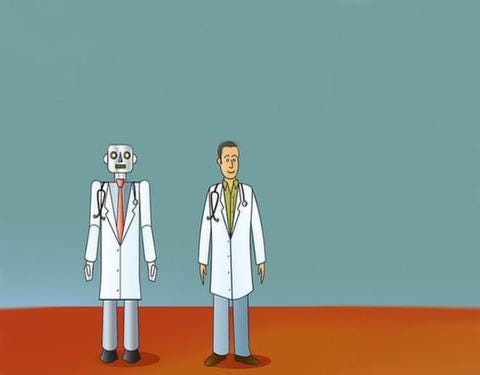Doctors Can Go Back To Tech SchoolDoctors Can Go Back To Tech School
Texas A&M-Dell academy to launch later this year aims to train medical pros on the latest healthcare technology -- and serve doctors moving into IT roles.


10 More Robots That Could Change Healthcare
10 More Robots That Could Change Healthcare (Click image for larger view and slideshow.)
One of the goals of Texas A&M's Health Science Center is to help doctors, medical students, and other healthcare professionals come to terms with the ways technology is changing their jobs. It will take a big step in that direction when it launches a new health technology academy later this year as part of its continuing medical education program.
A unit of Texas A&M University, TAMHSC operates on seven campuses statewide. TAMHSC is working with Dell to develop the academy, including collaborating on the curriculum.
The center initially will design the academy's curriculum to serve practicing physicians who want training in the latest healthcare information technologies. In the long term, the aim is to also serve undergraduate, graduate, and medical school students interested in careers in healthcare IT, said Dr. Paul Ogden, interim dean of medicine and interim VP for clinical affairs at TAMHSC, in an interview.
[Is that health app good for you? Read 10 Health Apps That Might Make You Sick.]
"There is a need [in healthcare] for folks who are IT people primarily and also physicians," Dr. Ogden says. "We've noticed that technology is rapidly changing and seems to be well ahead of where physicians are in most cases. Physicians are busy trying to maintain a clinical practice, are usually dealing with outdated technology, and have very little time to update it, or improve technology to improve patient care and make their practice more efficient. It's an area that needed innovation and education."
Some doctors "in older age groups" are slow to adopt technology, says Ogden. This challenge is compounded by clunky electronic health record (EHR) systems, many of which were built mainly to ensure that medical practices handle coding properly for insurance company billing. "Many physicians find [EHRs] difficult to transition to and very cumbersome when they try to do it."
The limits of EHRs are well publicized. In an open letter to health IT vendors posted on information.com, Mory Weschler, chief IT strategist for Montefiore Medical Center in New York, addressed the key issues:
Hospital systems are investing hundreds of millions of dollars in an [EHR] system that physicians and other eligible providers are not flocking to use. Why is this the case? Why do some clinicians complain the system gets in the way of treating their patients? Why is it difficult to train clinicians on how to place an order or print a barcode for a blood draw? From a patient perspective -- and as consumers of what has been referred to as the world's most expensive healthcare system -- is it too much to ask for access to a longitudinal medical record?
Then there are the government deadlines pressing down on healthcare organizations -- adoption of ICD-10 diagnosis codes by October of this year, and compliance with Meaningful Use Stage 2 going into next year. According to the 2014 HIMSS Leadership Survey, 71% of the 298 healthcare IT leaders who responded said they expect to be able to attest to Meaningful Use 2 compliance this year, and another 19% expect to get there in 2015. The deadline for conversion of systems to support ICD-10 diagnosis codes is October 2014, as dictated by the Centers for Medicare and Medicaid Services, but only 16% of respondents say that achieving this conversion is a priority for their organizations.
According to Dr. Cliff Bleustein, managing director and global head of healthcare consulting for Dell, two big IT challenges face physicians. "The first is learning how to use the technology itself, whether it's a tablet, a smartphone or EHRs," he told us. "Oftentimes, it requires learning the new system and how it operates. That's coupled with changing the way you work. You have to change the workflows and processes, and people have spent a tremendous amount of time establishing these. The introduction of new technologies requires a change in cultural mindset, policies and procedures, and changes in workflows. It’s different from current ways they do medicine."
With that challenge in mind, the TAMHSC courses will focus not only on technology, but also on the broader issues of change management, governance, compliance, and security. "It's important that organizations have an assessment around their security to see what they can do to make improvements," says Bleustein.
Ogden thinks technology is going to be a bigger and bigger part of every medical practice.
"All physicians should be on EHR in the next five years," he says. "I see physicians working with tablets and smartphones. They're using apps on their phones to monitor patients to track disease. We're seeing large chunks of information coming into the doctor's office externally from patient-monitoring devices that have to be evaluated and managed. The amount of information will be huge, and systems will need to be built around that in order to allow physicians to use it. It's not like an old paper record that sits in a drawer and nobody looks at."
What do you think? Are TAMHSC and Dell on the right track with their healthcare technology academy? Is it necessary for a new discipline to emerge that combines clinical know-how with technological skill, a sort of Dr. CIO? Also, what are your biggest concerns about EHRs and the increasingly tech-dependent state of healthcare? Share your thoughts with us in the comments section below.
In its ninth year, Interop New York (Sept. 29 to Oct. 3) is the premier event for the Northeast IT market. Strongly represented vertical industries include financial services, government, and education. Join more than 5,000 attendees to learn about IT leadership, cloud, collaboration, infrastructure, mobility, risk management and security, and SDN, as well as explore 125 exhibitors' offerings. Register with Discount Code MPIWK to save $200 off Total Access & Conference Passes.
About the Author
You May Also Like






